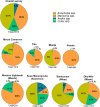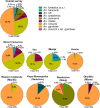Bionomics and vectorial role of anophelines in wetlands along the volcanic chain of Cameroon
- PMID: 30107815
- PMCID: PMC6092805
- DOI: 10.1186/s13071-018-3041-z
Bionomics and vectorial role of anophelines in wetlands along the volcanic chain of Cameroon
Abstract
Background: The epidemiological profiles of vector-borne diseases, such as malaria, are strongly associated with landscape components. The reduction of malaria burden in endemic and epidemic regions mainly depends on knowledge of the malaria-transmitting mosquito species, populations and behavioural characteristics, as well as malaria exposure risks. This work aimed at carrying out a holistic study in order to characterise Anopheles species in relation to human malaria in seven wetlands along the lower section of the volcanic chain of Cameroon.
Results: Eight malaria vectors: Anopheles arabiensis, An. coluzzii, An. funestus (s.s.), An. gambiae, An. hancocki, An. melas, An. nili and An. ziemanni, were found biting humans. Anopheles gambiae was widespread; however, it played a secondary role in the Ndop plain where An. ziemmani was the primary vector species (79.2%). Anophelines were more exophagic (73.6%) than endophagic (26.4%), showing a marked nocturnal activity (22:00-4:00 h) for An. coluzzii and An. gambiae while An. funestus (s.s.) was mostly caught between 1:00 and 6:00 h and An. ziemanni having an early evening biting behaviour (18:00-00:00 h). Female Anopheles were mostly observed to have relative high parity rates (≥ 70%), with the exception of the Meanja site where species parity varies from 46 to 55%. Overall, the transmission level was low with entomological inoculation rates estimated to 0.7 infected bites per person per month (ib/p/mth) in Tiko and Ndop, 1.4 ib/p/mth in Mamfe and 2.24 ib/p/mth in Santchou.
Conclusions: The present study represents detailed Anopheles vector characterisation from an understudied area along the volcanic chain of Cameroon with endemic malaria transmission. The significant differences in bionomics and Anopheles species distribution within the studied wetlands, highlights the importance of providing baseline data and an opportunity to assess the outcome of ongoing malaria control interventions in the country.
Keywords: Anopheles vectors; Malaria; Volcanic chain of Cameroon; Volcanic massif; Wetlands.
Conflict of interest statement
Ethics approval and consent to participate
The protocol used for this study received ethical approval from the Cameroon National Ethics Committee (CNEC) and administrative approval from the Ministry of Public Health of Cameroon. The various aspects of the work were conducted in collaboration with the local district administration. In each community, details were given about potential risks and benefits of the study to the community leaders, head of households and potential mosquito collectors. It was explained that participation was voluntary, and investigators provided a written informed consent form which was signed by the head of households and mosquito collectors. Households were sprayed at the end of the survey, and presumptive malaria treatment was given throughout the study to mosquito collectors as recommended by the National Malaria Control Programme.
Consent for publication
Not applicable.
Competing interests
The authors declare that they have no competing interests.
Publisher’s Note
Springer Nature remains neutral with regard to jurisdictional claims in published maps and institutional affiliations.
Figures





References
-
- Atangana J, Fondjo E, Fomena A, Tamesse J, Patchoké S, Ndjemaï H, et al. Seasonal variations of malaria transmission in Western Cameroon highlands: entomological, parasitological and clinical investigations. J Cell Anim Biol. 2009;3:33–38.
MeSH terms
LinkOut - more resources
Full Text Sources
Other Literature Sources
Medical

